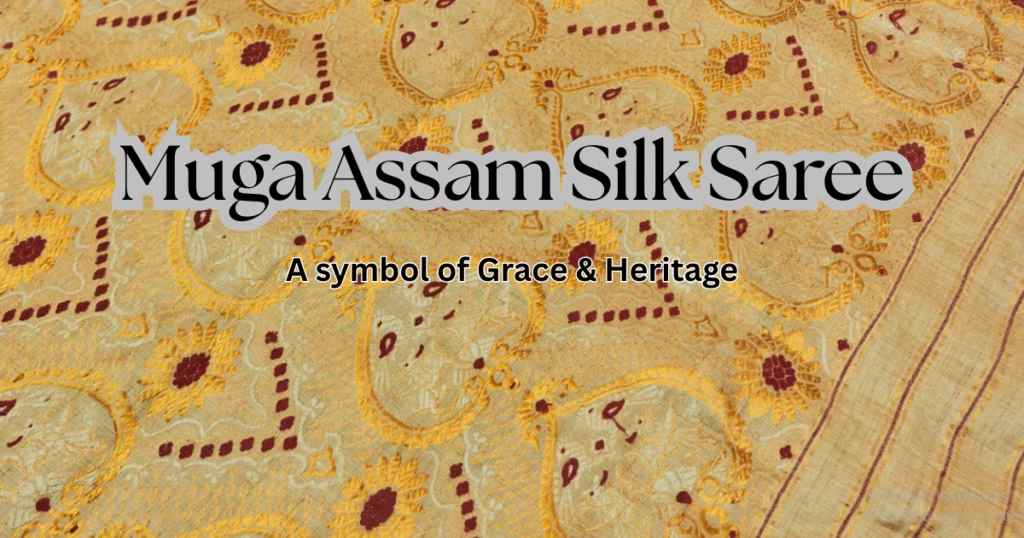
Introduction
The Indian textile tradition is also a rich trove of traditions and stories, in addition to the heritage and craft that have been passed down from generation to generation. One of the crown jewels of Indian handloom is the Muga Assam silk saree, a golden-colored beauty that embodies grace, elegance, and cultural pride. This silk saree, although a possession of clothing, is not only a clothing that has managed to be a denizen of tradition and art. Being a tradition and a legacy of art, the very idea was born in the Assamese state of Assam. The rich state in vegetation and serenity, Assam is, in itself, a living thing of art.
The Ancient Roots of Muga Silk
Muga Assam silk saree can be dated back to ancient times, and it is believed to have been used by members of royal families and aristocrats already in the times of the Ahom dynasty (the 13th century). The name Muga is an Assamese word that translates to amber, since this kind of fabric has an original golden-yellow shimmer. Muga silk is the only one that can only be produced by Antheraea assamensis, which is grown in the area of Assam only, and is fed on two local plants, Soom and Som leaves.
The use of Muga silk at religious functions, marriages, and festivals is recalled in historical books and literary works in Assamese scriptures. The saree was so prestigious that many times they were offered to the kings and deities. The traditional Assam silks, what is popularly called the silk sarees today, are considered prized heirlooms that are passed on generation.
The Making of a Muga Assam Silk Saree
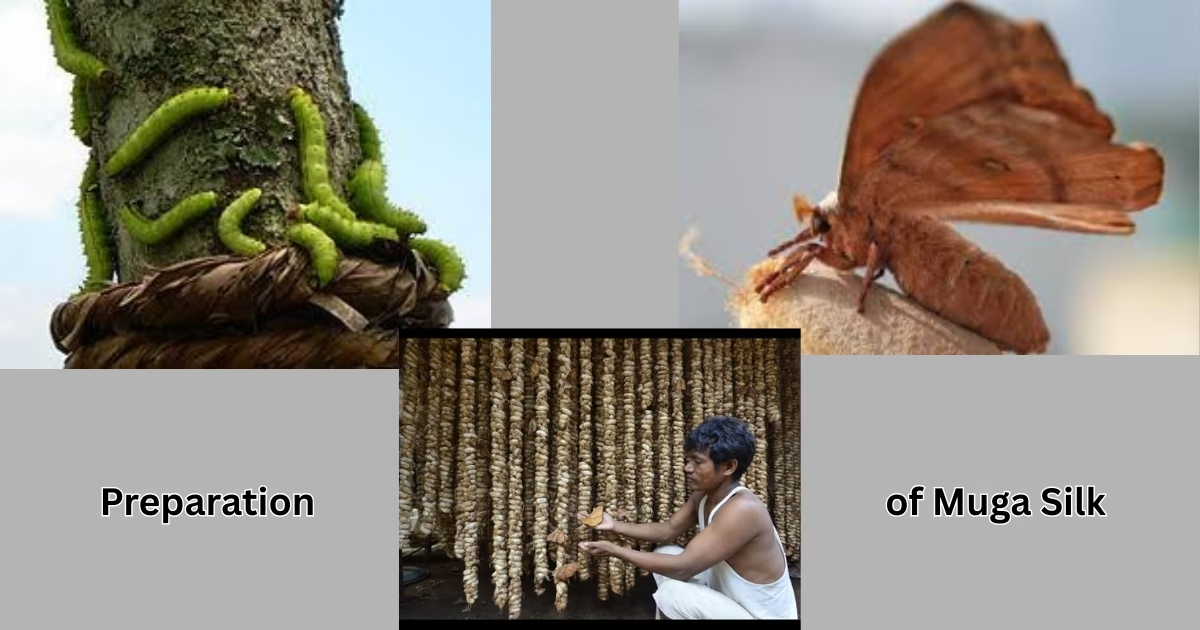
The process of weaving a Muga Assam silk saree has been long and tedious, requiring much patience, dexterity, and hard work. It can go on for months and involves dozens of craftspeople: From collecting the silkworms to the weaving of the final textile.
-
- Silkworm Cultivation: The Muga silkworm is grown in nature, and it eats special leaves which give a golden shine to the silk.
-
- Cocoon Collection & Boiling: When they grow, the cocoons are gathered and boiled down gently to get the silk threads.
-
- Spinning & Dyeing: The fibers are the same original golden color spun with no artificial dyes, making them organic and retaining their sheen and durability.
-
- Weaving: Skilled weavers then utilize traditional looms to hand-weave the threads, and usually with elaborate patterns that have a natural origin, like flowers, birds, and tribal designs.
It is because of this painstaking and craft-oriented artwork that each Muga Assam Silk Saree becomes an embodiment of a priceless work of art.
Unique Features of Muga Silk
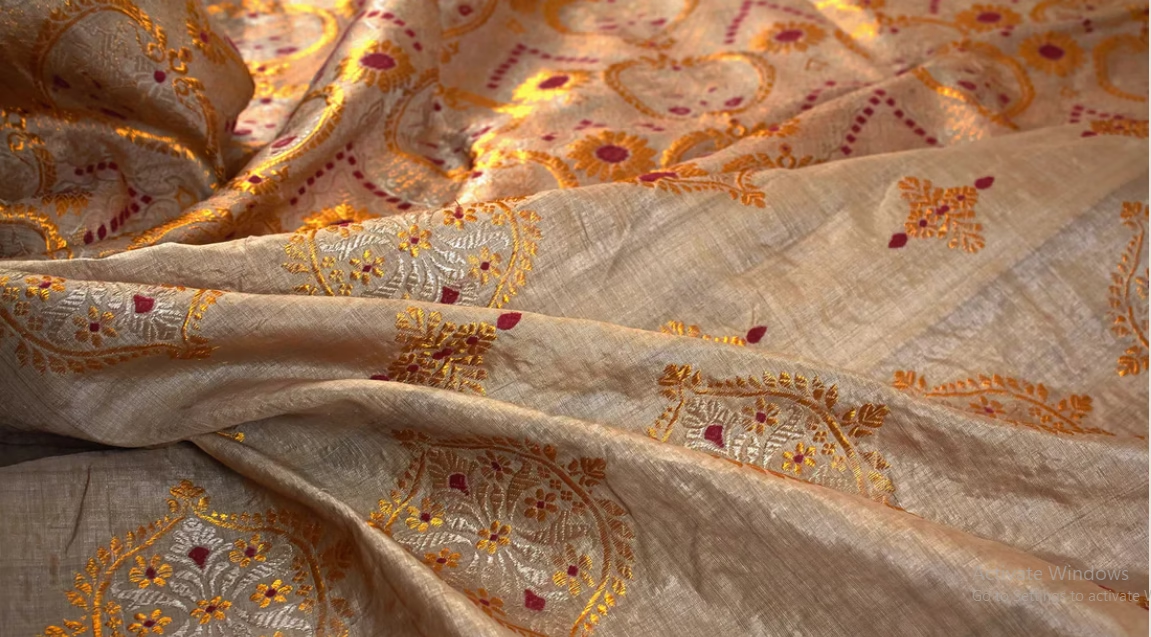
The Muga silk that is used in Assam silk sarees happens to have some of the most uncharacteristic and unique properties among natural fibers:
-
- Golden Natural Hue: The natural lustre and golden colour of Muga silk is unmatched and does not require artificial colouring.
-
- Durability: Muga sarees are durable and last a long time for the buyer. People say that Muga gets shinier with time.
-
- Breathability: Despite being luxurious, Muga silk is breathable and ideal for the humid climate of Assam.
-
- Natural Shine: Unlike other silks that may lose their sheen, Muga Assam silk sarees retain their natural sheen even after repeated use and washing.
The Cultural Significance of Assam Silk Sarees
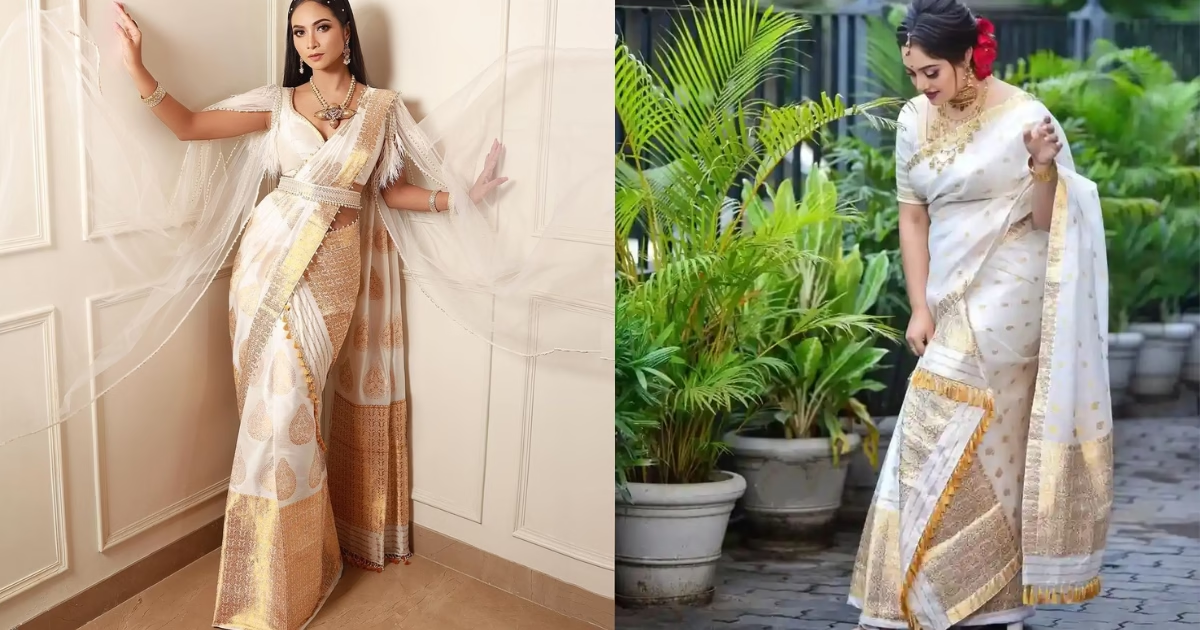
For Assamese people, especially Assam silk saree (Muga variety) is important to Assamese culture. This attire is often worn at big festivals like Bihu, weddings, and religious events. Saree is not only a symbol of beauty, but it also reminds us of our roots.
In Assamese weddings, brides are mostly seen wearing a mekhela chaadar—this traditional two-piece made of muga silk symbolizes purity, good fortune, and blessings for a new life. The sari is so sacred that it is even worn in temples and ancestral ceremonies.
Designs and Patterns
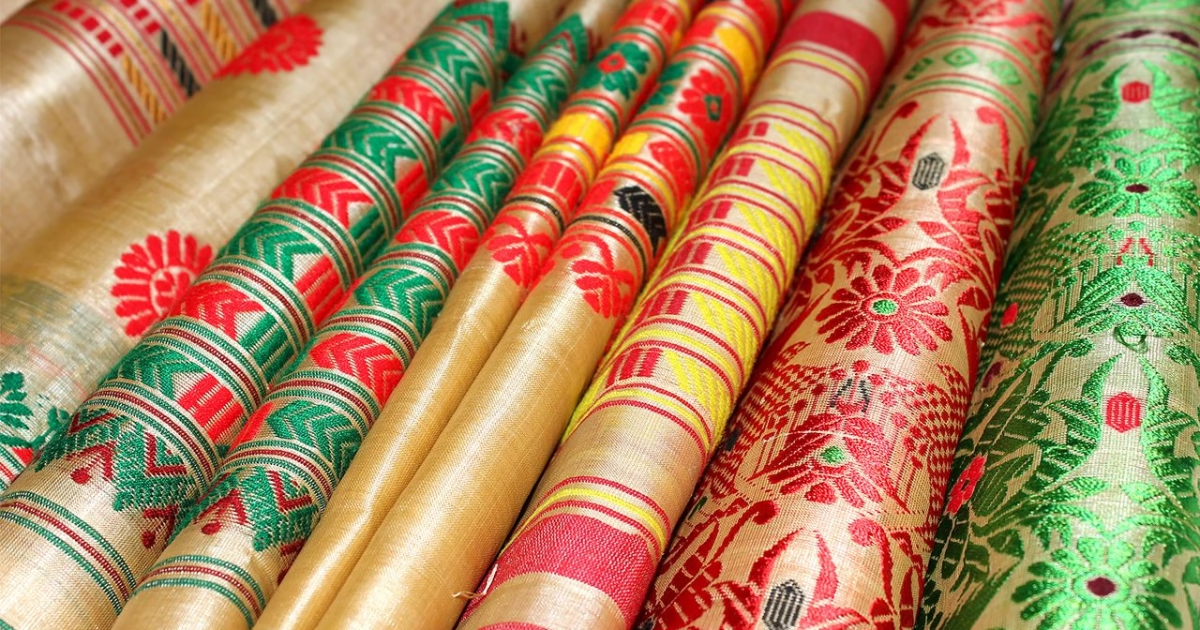
The traditional Muga Assam silk saree is simple in nature. However, in this century, different varieties of patterns and designs are incorporated into the saree, and the designs of embroidery exhibit a fair diversity:
-
- Traditional Motifs: Patterns were based on Assamese motifs that included designs based on lotus, creepers, peacock, and rhinoceros.
-
- Tribal Art: One can find tribal artworks on many saris that portray indigenous culture.
-
- Golden Thread Work: In many cases zari (gold thread) is incorporated into the border and pallu making it even more royal.
Some of these modern designers are even experimenting and mixing the Muga silk with the latest silhouettes and transforming the saree into designer wedding, fashion week, and red carpet attire worn by celebrities.
Muga Silk and Geographical Indication (GI) Tag
The Government of India declared Muga silk a Geographical Indication(GI) tag in recognition of its geographical and cultural uniqueness of Muga silk. This implies that only genuine production of Muga Assam pure silk sarees can be done in Assam state, thus maintaining the tradition and economic security of the weavers of this region.
GI tag has assisted in increasing the awareness and demand of these sarees globally. The Muga silk is today exported all over the world to different countries such as Japan, the UK, and the US.
Challenges Faced by the Muga Silk Industry
The Muga silk industry, though having a rich past, has many challenges:
-
- Climate Change: The Muga silkworm is sensitive to changes in the environment. Changes in environmental temperature and humidity have a direct impact on cocoon production.
-
- Deforestation: The disappearance of Som and Soalu trees affects the availability of food to the silkworms.
-
- Counterfeit Products: Frauds of fake Muga or mixtures of silk are being sold as original sarees in the market, and this has been a killer livelihood for the weavers.
-
- Low Wages for Artisans: Even though the cost of the product is as high as the retail price, due to the high retail price, the weavers are paid much less.
The government and NGOs are trying to retain this art by marketing Assam silk sarees, holding skill development training programs, and encouraging organic farming of silkworms.
How to Identify an Authentic Muga Assam Silk Saree
While purchasing Muga Assam silk sarees, search for these authenticity marks.
-
- Color and Sheen: The fabric should have a rich golden-yellow hue with a glowing shine.
-
- Texture: Muga silk is rougher and heavier than mulberry silk, but very soft to touch.
-
- Burn Test: Genuine Muga silk smells like burnt hair when exposed to flame and turns to ash.
-
- GI Tag or Certification: When in doubt about the origin of a product, always request GI certification or purchase goods from well-established weavers or cooperatives.
Conclusion: Owning a Legacy
Muga Assam silk saree is not just a luxury fabric garment; it is a symbol of India’s rich cultural heritage, harmony with the ecosystem, and mastery of weaving. Whether you wore it on an occasion or to carry it as a family heritage, every sari has stories of the land, the loom, and the legacy of Assam.
Therefore, when you put on a Muga Assam silk saree next time, keep in mind that you are not talking about wearing a silk; you are talking about putting on history, art, and the soul of Assam.
Want to know more about the silk sarees of different regions? Kindly go through the other blogs.
FAQs
What makes the Muga Assam silk saree unique?
The Muga Assam silk saree is famous for its original golden glow, which clashes with time and is celebrated in their culture. It is produced only in Assam with silk from the very rare Antheraea assamensis moth.
How can I identify an original Muga Assam silk saree?
Genuine Muga silk is golden-yellow in colour, silky and soft, but has a natural texture and shine. It is always better to buy it from reputed sellers or look for the GI tag for authenticity.
Are Assam silk sarees suitable for all occasions?
Yes, Assam silk sarees and mostly Muga type of saree are very nice in weddings, festivals, and official functions. They are classic items because of their beauty and history.
